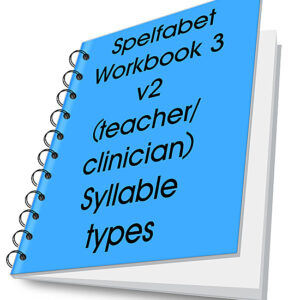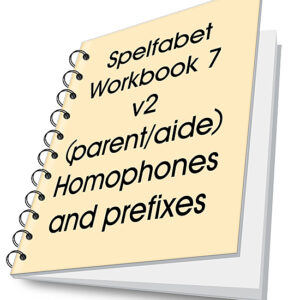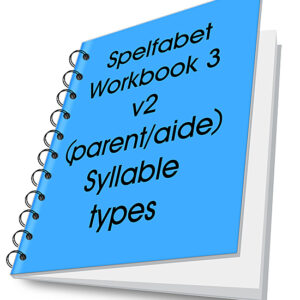Workbook 5 – teacher/clinician version
$AUD19.79
Downloadable 80-page illustrated workbook you may print up to 50 times, which gives learners multiple opportunities to practice the spellings of following vowel sounds in common words:
- “ar” as in car, last, half, aunt, baa, galah, clerk, heart.
- “er” as in term, dirt, turn, learn, word, stirred, purr, journal, colonel, secateurs, myrtle, myrrh, hors d’oevres.
- “or” as in form, saw, more, four, roar, poor, brought, caught, war, author, walk, water, broad.
- “ou” as in loud, cow, drought, kauri, Laos, Maori, miaow, sauerkraut.
- “oy” as in soy, soil.
- “air” as in care, hair, aeroplane, bear, parents, theirs, there.
- “ear” as in hear, cheer, here, pier, hero, souvenir, weird.
- “e” as in head, any, bury, friends, leisure, leopard, said, says, Thames.
A sorting activity is included after each vowel sound, to allow the learner to write lists of words with the same spelling of that vowel, then examine them for patterns. Additional spellings practised are: ea as in head, a as in wallet, o as in mother, re as in centre (usually spelt er in US English), and our as in harbour (usually spelt or in US English).
Description
80 pages of synthetic phonics activities designed for learners of any age who can write one and two-syllable words with “short” and “long” vowels spelt a variety of ways, some other vowel digraphs, and now need to learn how the rest of the vowel sounds are spelt. View the workbook’s video tour here. Download a free sample of the workbook here.
This workbook contains straightforward activities, so you don’t need special training or expertise to help a learner use it. It walks you through the task of learning multiple spellings for each of the following vowel sounds:
- “ar” as in car, last, half, aunt, baa, galah, clerk, heart.
- “er” as in term, dirt, turn, learn, word, stirred, purr, journal, colonel, secateurs, myrtle, myrrh, hors d’oevres.
- “or” as in form, saw, more, four, roar, poor, brought, caught, war, author, walk, water, broad.
- “ou” as in loud, cow, drought, kauri, Laos, Maori, miaow, sauerkraut.
- “oy” as in soy, soil.
- “air” as in care, hair, aeroplane, bear, parents, theirs, there.
- “ear” as in hear, cheer, here, pier, hero, souvenir, weird.
- “e” as in head, any, bury, friends, leisure, leopard, said, says, Thames.
A sorting activity is included after each vowel sound, to allow the learner to write lists of words with the same spelling of that vowel, then examine them for patterns.
Extra spellings practised at the end of this book are:
- ea as in head,
- a as in wallet,
- o as in mother,
- re as in centre (usually spelt er in US English),
- our as in harbour (usually spelt or in US English).
All activities incorporate pictures, to add meaning and build vocabulary. Pictures are mostly simple, computer-generated line drawings from the Mayer-Johnson Picture Communication Symbols, and are used with permission. They are suitable for all ages.
This workbook should be used in conjunction with other synthetic phonics activities at the same skill level, such as the games on this website, the movable alphabet, decodable books and relevant apps/software. To make good progress, your learner should do three to five practice sessions a week, ideally completing one or two sets of workbook words at a time, then do some reading, games, word-building etc. at the same level.
Please note that this workbook is supplied as a pdf file which you download and print yourself. This keeps it affordable. Please print on scrap paper if you can, to save trees. You can purchase using a credit card, you don’t need a PayPal account.
The workbook comes with a cheat sheet listing all the words in the workbook and suggested sentences for each, so you don’t have to figure out what the target words are, and can work quickly. The aim is that your learner has lots of practice writing words with the same vowel sound, noting the different ways it is spelt, where these spellings occur (beginning, middle or end of words), in what types of words, and whether there are other sounds/spellings that tend to be used with it.
You may make up to fifty copies of this workbook, for use with your own students/clients. You might consider it most suitable as a simple, hard-to-get-wrong homework activity, and just check it each week/session.







